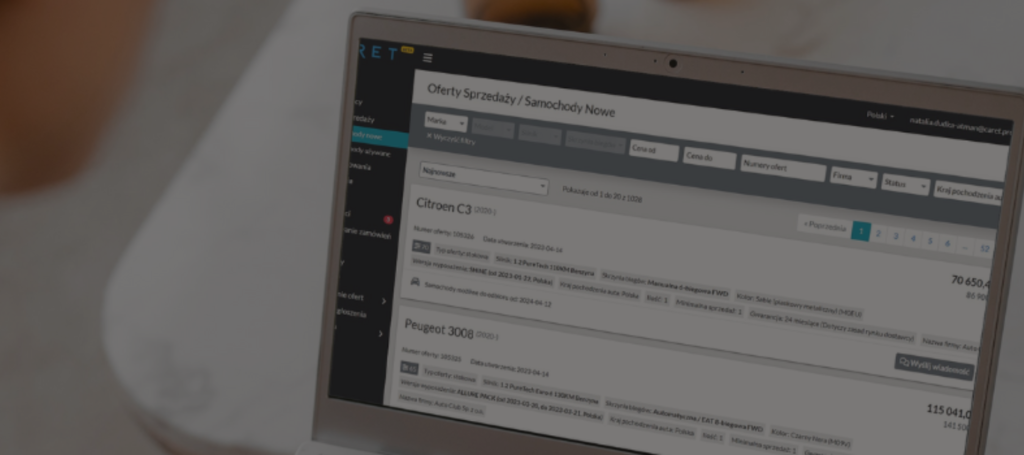
Fleet cars constitute a significant element of the operation of almost every business. Choosing the right vehicles for specific tasks marks the beginning of the life cycle of a fleet car. Explore the various stages of a car’s use and determine the most advantageous time to sell a vehicle retired from service in the business.
What are the key stages of the life cycle of a fleet car in a business?
Effective fleet management is crucial not only for efficiency but also for cost optimization in a business. Therefore, we have broken down the life cycle of a fleet car into its primary factors to understand the importance of each.
We have divided the life cycle of a fleet car into four phases:
- planning and purchasing the vehicle
- maintenance and servicing
- monitoring and control
- withdrawal and replacement of fleet vehicles
What does the life cycle of a fleet car look like in practice?
The first stage in the life cycle of fleet cars is the comprehensive planning of vehicle purchases.
This is a complex task that requires consideration of many essential factors. It is crucial to determine the number and type of vehicles needed at the outset. The analysis of fleet maintenance costs, including the purchase price, fuel consumption, and expenses related to vehicle servicing and insurance, is undoubtedly vital. Additionally, attention should be given to the length and conditions of the manufacturer’s warranty.
Preferences for choosing a car often differ depending on the industry in which a company operates and expands its fleet. For a transportation services company, load capacity and cargo space are important, while commercial enterprises choosing cars for their representatives consider not only practical aspects but also the brand image. This latter factor is particularly significant when selecting fleet cars for upper management or the company’s board. At every stage of selecting cars for your corporate fleet, you can rely on the expert support of CARET platform professionals.
Maintenance and servicing is the second stage of the life of a fleet car.
A company car should be in impeccable condition, because thanks to this it will serve its function in the company for a long time and without any problems. Proper maintenance of a fleet car is not only about filling up with good quality fuel and adding windshield washer fluid. Key to the process is servicing the vehicle according to the manufacturer’s guidelines. Nowadays, instead of predefined intervals for oil changes and inspections, manufacturers often equip cars with diagnostic systems. In such cases, when wear or the need for a technical inspection is detected, the vehicle informs the driver about an upcoming visit to the service center. Maintenance tasks also include seasonal tire changes. To maintain full control over all costs, many companies opt for installing GPS in their vehicles. This solution allows monitoring cost sources and making decisions based on data.
Monitoring and control is the third stage in the life of a fleet car.
Maintaining records of mileage or service activities in the form of notebooks or Excel spreadsheets is not considered efficient.
Modern fleet monitoring systems enable quick and easy control of every car within a corporate fleet. Instant access to data regarding fuel consumption, location, and driving time ensures full control over a fleet of any size.
Implementing advanced vehicle monitoring is an investment that pays off. Therefore, it is worth exploring the comprehensive offerings of CARTRACK, a company known for intelligent solutions supporting safe and efficient control of fleet cars. The provided solutions are effective and ensure fully remote fleet management through GPS monitoring.
Withdrawing a car from use is the final stage in the life cycle of a fleet car. The term might imply the necessity to stop using a vehicle due to its significant age, mileage, or poor technical condition. In the past, cars were used until they reached their durability limits due to a lack of new vehicles on the Polish market. Currently, the situation is entirely different. The withdrawal of a car is primarily done for economic and tax reasons.
The final phase of a fleet car’s life cycle presents the optimal moment to sell.
But why? The leasing period is typically limited to 60 months, and many businesses choose a shorter repayment duration. Once the lease term is up, vehicles often get bought. This signifies the conclusion of tax benefits, in which monthly leasing payments are no longer tax-deductible as income expenses. Furthermore, a vehicle utilised over multiple years may display indications of deterioration and variances in components relative to the latest models currently obtainable. These factors establish that the termination of a lease agreement presents the most opportune moment to merchandise a fleet car.
How to sell a fleet car for maximum profit?
A fleet car with a comprehensive service history generally holds its value. Also, selling a retired vehicle with a Value Added Tax (VAT) invoice has numerous advantages for potential buyers. Firstly, they can save 2% on the Tax on Civil Law Transactions (PCC). Secondly, those involved in business activities can lease the car.
There are various options for selling a leased car, including:
- self-sale. To sell your car independently, consider advertising it on a popular paid classifieds portal.
- you could opt for dealer sales where you exchange your car for cash with a dealership. This is a convenient option, but the price you receive is often much lower than market value.
- alternatively, you could use the CARET platform, which allows you to advertise your car to professional dealers all over Europe. They offer prices that are in accordance with the prevailing market situation, and without any extra charges. A substantial benefit is that the transactions are at par with those of a Polish purchaser, which eliminates worries regarding superfluous formalities or invoicing of net amounts.
Selling a car independently can present its own difficulties. When valuing a retired fleet car, determining its value solely by analysing similar car sale ads can lead to mistakes, risking setting the price too high or too low. In the former scenario, there will be minimal interest in the car, while in the latter, some profits may be lost upon sale. Furthermore, it is possible that certain individuals who respond to the advertisement may submit unfavourable purchase or exchange offers or lose interest and terminate communications after receiving all necessary information.
A practical solution for the profitable sale of fleet-repossessed cars is to employ the proficient services offered by CARET platform. It takes only a few minutes to create a free account, after which you can effortlessly post an advertisement for your car’s sale. This will be viewed by hundreds of car dealers from across Europe. You can rest assured of impeccable support from CARET experts at every sales phase. Thanks to our platform, you need not worry about language, legal, or tax barriers. Simply select the optimal offer and allocate the revenue from the sale towards purchasing new vehicles for your fleet. You can explore our extensive selection of new cars on offer.
For a hassle-free, profitable sale of retired fleet vehicles, make use of CARET’s professional services; creating an account is a quick and easy process. Afterwards, you can effortlessly advertise the sale of your vehicle, which will reach numerous automotive professionals across Europe. At each point during the transaction, you can depend on the unwavering support of CARET platform experts. This will alleviate any concern regarding legal, tax, or linguistic challenges. Simply select the most beneficial offer, and the proceeds from the sale can be utilised to acquire new vehicles for your fleet. Don’t forget to explore our vast array of new car purchasing options available on our platform.
When should you consider buying used vehicles for your company fleet?
Relatively new cars from national dealerships are a hit with both private customers and businesses. The presence of documented service histories and a lack of serious accidents, coupled with significantly lower prices than new cars, make for some strong arguments. Additionally, you can take advantage of attractive financing options for the purchase of used vehicles, with the added benefit of similar tax advantages as buying new.
Why are well-maintained fleet cars an attractive choice for buyers?
Fleet cars possess various factors that make them appealing in the used vehicle market:
a. Well-maintained: Fleet cars receive regular servicing, which ultimately improves their reliability and resale value.
b. Lower mileage: Fleet cars often have lower mileage than private vehicles as they are used for business purposes, resulting in less wear and tear. c. Competitive pricing: Additionally, fleet cars are usually available at competitive prices. Fleet vehicles are frequently priced competitively in the second-hand vehicle market, posing as attractive options for budget-conscious purchasers. Detailed documentation on inspections, repairs and the vehicle’s history is maintained by companies, ensuring transparency and instilling confidence in the buyer about the vehicle’s condition. Moreover, fleets offer a diverse range of vehicles to choose from. Companies frequently maintain an extensive vehicle selection, providing purchasers with ample options to explore across various makes, models, and specifications. Opting to procure a pre-owned automobile through our platform guarantees assistance from a proficient team throughout the order process.
At CARET, access thousands of listings featuring used cars in superb mechanical shape. Opting to procure a pre-owned automobile through our platform guarantees assistance from a proficient team throughout the order process.




